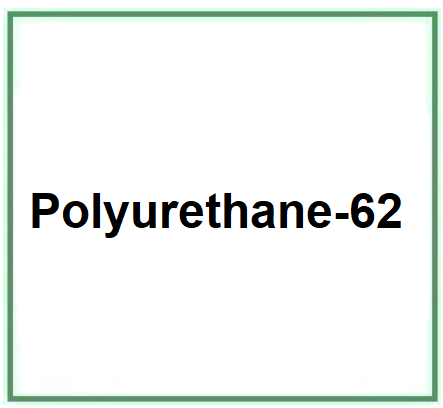Polyurethane-62 is an inorganic chemical compound, a segmented block copolymer derived from urethane and synthesised from isocyanates.
The name describes the structure of the molecule:
- "Polyurethane" is a term that describes a class of polymers widely used in various applications due to their versatility and desirable properties such as durability, flexibility and abrasion resistance and temperature variations.
- "-62" is a reference to the specific type or grade of polyurethane, which can be characterized by such factors as the types of isocyanates and polyols used, their relative amounts, and the presence of any additives. . This is a designation used to differentiate different molecular structures or variants of the polymer. In cosmetic chemistry, these numbers can help formulators identify specific characteristics or behaviors of a given ingredient, particularly when a chemical family has multiple derivatives or forms.
Significant substances used in the production method:
- hexamethylene diisocyanate, PEG-200, Methyl Gluceth-10, Trideceth-6 monomers, fatty alcohol containing 16 to 20 carbons.
- Description of the raw materials used in production and their functions:
- Hexamethylene Diisocyanate. Diisocyanate used to react with polyols to form polyurethane. Imparts strength and stability to the polymer.
- PEG-200. Polyethylene glycol with a molecular weight of 200. Used as a polyol in the polyurethane to increase elasticity and hydration.
- Methyl Gluceth-10. A humectant and skin-conditioning agent, improves the skin feel and appearance of the polyurethane.
- Trideceth-6. An emulsifier that assists in forming stable emulsions.
- Fatty alcohol containing 16-20 carbons. Used to end-cap the polymer chain, adding lipophilic properties to the polyurethane, enhancing solubility in oils and lipids.
Step-by-step industrial synthesis:
- PEG-200 and Methyl Gluceth-10 are mixed in a reactor to prepare the polyol base.
- Hexamethylene Diisocyanate is subsequently added to the polyol mixture, initiating the formation of the polyurethane.
- Trideceth-6 is introduced into the mixture, functioning as an emulsifier.
- Once the desired molecular weight is achieved, the fatty alcohol containing 16-20 carbons is used to end-cap the polymer chain.
- The resulting polyurethane is then cured either through a thermal or UV process, stabilizing its structure.
What it is used for and where
Cosmetics
Viscosity Enhancing Agent - aqueous. Since viscosity is important for increasing the chemical and physical stability of the product, Viscosity Enhancing Agent acqueous is an important dosage factor in gels, suspensions, emulsions, solutions. Increasing viscosity makes formulations less sedimentary and more homogeneously thickened.
Binder agent. Ingredient that is used in cosmetic, food and pharmaceutical products as an anti-caking agent with the function of making the product in which it is incorporated silky, compact and homogenous. The binder, either natural such as mucilage, gums and starches or chemical, may be in the form of a powder or liquid.
Surfactant - Suspending agent. Cosmetic or pharmaceutical suspensions are known to be thermodynamically unstable and it is therefore essential to include in the formulation a suspending agent capable of dispersing any sedimented particulates and reducing the rate of sedimentation. The presence of this agent increases the consistency of the suspension medium and exerts a protective colloidal action with a surfactant action.
It appears as a white powder or colorless liquid.

Safety
Urethane (also called ethyl carbamate) is a by-product of fermentation and is considered a genotoxic agent.
Polyurethanes are rather complex, inert and biostable materials that are also used in biomedical applications. They are typically synthesised by the reaction of a glycol or polyol with polyisocyanate or diisocyanate. It is known that exposure to isocyanates can cause asthma, contact allergies, conjunctival and skin irritation. However, a study by the Cosmetic Ingredient Review Expert Panel in 2017 found that the rates of harmful residues are not significant for human health. (Treated cells had 63% survival. Survival >60% is considered negative for ocular irritation.)
![]() Polyurethane-62
Polyurethane-62 


